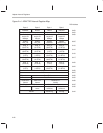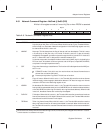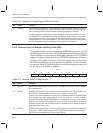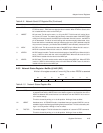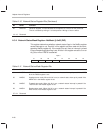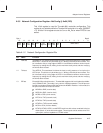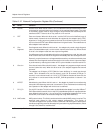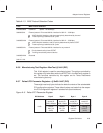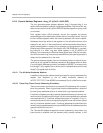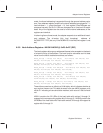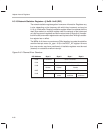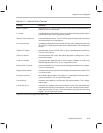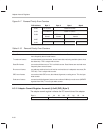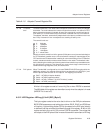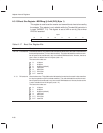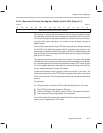
Adapter Internal Registers
A-30
A.3.8 General Address Registers–Areg_0-3 @ 0x10–0x24 (DIO)
The four general-purpose address registers, Areg_0 through Areg_3, are
used to hold the adapter’s specific and group addresses. Each of the four reg-
isters can be used to hold any 48-bit IEEE 802 address (specific or group, local
or universal).
Each register holds a 48-bit address, and all four registers are directly
compared against the destination address field of incoming frames. If any of
the four address registers match the incoming address, the frame is copied.
Addresses should be written to the registers in the native data format of the
protocol in use; that is, in the same format in which the address field of the re-
ceived frame appears in memory. As an example, the group/specific bit of an
Ethernet-style frame appears in the Areg bit 40 (LSB of MSbyte). In contrast,
the same bit in a token ring style frame appears in bit 47 (MSB bit of
MSbyte).This is because the Ethernet frame format uses LSB first transmis-
sion while the token ring frame format uses MSB first (the specific/group bit is
always the first address bit on the wire).
The general address registers have an addressing lockout function that pre-
vents use of any register for address comparison while being written or when
it is uninitialized. Addressing lockout is enabled at NRESET or whenever the
first (Areg[47::40] ) register byte is written and it is disabled whenever the last
(Areg[7::0]) register byte is written.
A.3.8.1 The All-Nodes Broadcast Address
In addition to the general address matching of specific or group addresses, the
adapter also responds to the all nodes broadcast address of
0xFFFF FFFF FFFF if the NOBRX (no broadcast Rx) bit in NetCmd is not set.
A.3.8.2 Token Ring Frame Format Addressing Extensions
There are a number of extensions to the basic 802 addressing that is used in
token ring networks. Token ring provides functional addresses as a subset of
the local-group addresses and an all nodes (this ring) broadcast address.
Functional addresses provide bit position-based addressing of common net-
work functions. Bit positions 30 through 0 of the incoming destination address
are compared with 31 functional address bits (stored in a register). If any in-
coming functional bit has its corresponding register bit set, the frame is copied
due to a functional address match. Functional addresses are identified from
normal local group addresses by having the MSB of the third address byte (the
group/functional bit) set to a 0.
The ThunderLAN adapter supports functional addressing, when token ring
frame format is selected over the demand priority access method. In this



